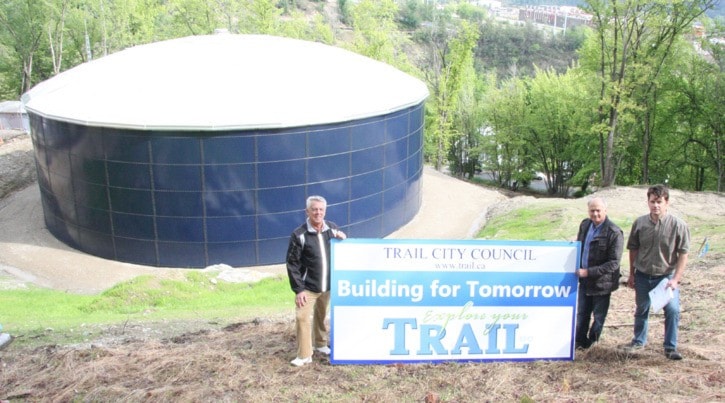With a turn of the tap, a staple of life in Greater Trail received an important upgrade earlier this month.
At the beginning of May, water began to flow from the brand new $2.1 million Coleman Street Reservoir.
“We don’t see projects this big very often,” Trail Councilor Gord DeRosa on Thursday. “This was a matter of replacing aging infrastructure with state of the art.”
The new structure replaces the original open-top concrete pit reservoir, which was over 70 years old and posed the obvious health and maintenance factors.
“The age of the old reservoir, the unreliability of water quality, there were so many unknowns,” explained John Howes, an engineering technician for the City of Trail. “We were being very proactive on this one.”
The new reservoir, which holds 3.5 million litres of water, roughly the same as the old one, will service the West Trail corridor and into portions of downtown.
DeRosa explained the opportunity to replace the old reservoir arose thanks to the city setting aside funds from the federal government’s Gas Tax Program over the years.
The federal input into the project is expected to cover over half the cost. The final tally has yet to be rung up but early estimates are the federal grants will cover approximately $1.3 million of the overall cost.
At first glance the new reservoir, located high atop Columbia Heights below the Annable neighborhood, resembles a flying saucer landing on the hillside.
Howes said the design is much nicer than the usual concrete rectangle and was the main design put forward by manufacturer.

“That’s their standard design.”
But it’s what’s inside that counts, he explained.
The main tank is lined with glass-fused steel whereas traditional steel tanks suffered from corrosion.
“It’s virtually maintenance free,” said Howes.
DeRosa added that if maintenance is required, the task will be much easier.
The city had dealt with several issue surrounding the old reservoir including installing a floating cover to protect the stored water. However, the cover had a life expectancy of only a few years and the cost of replacement was anywhere from half a million to a million dollars.
“You get all that work done and nobody can guarantee it will last more than four or five years,” said DeRosa.
That prompted the city to begin exploring a replacement facility. An evaluation revealed a new reservoir was the most economical route and ensured quality water for residents for years to come.
All that’s left on the project, which began in September, 2011, is the demolishing of the old reservoir.
“That’s where we’re at now,” said Howes.
Part of the decommissioning of the old reservoir will include repairs to Coleman Street. The old reservoir location will also be used as access and parking for the new reservoir.
